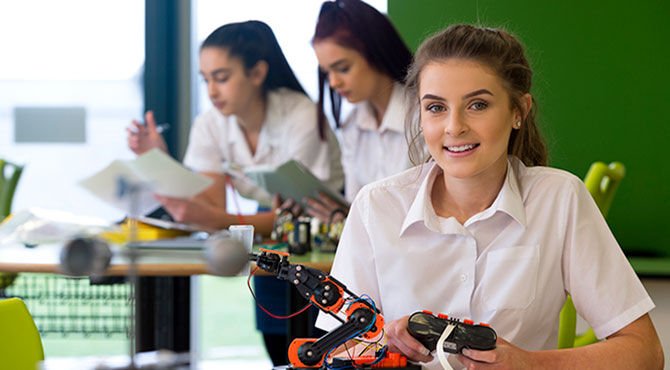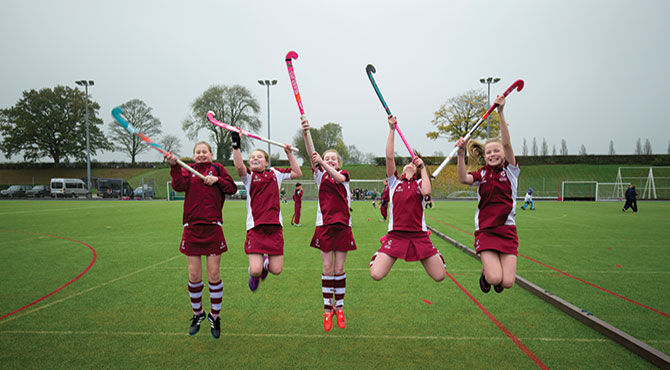A single sex or mixed education?
For many years, and in many countries around the world, parents have wondered whether a coeducational (mixed) school or a single-sex school is the best option for their children.

Historical context
Until the end of the 18th century, single-sex education was commonplace around the world. During the 19th century, more and more coeducational schools were set up.In many countries, single-sex education has almost vanished, but there are some countries, such as the UK, where it is still a viable option, depending on where you live.In other countries, particularly in Asia, single-sex education has prospered as the result of religious and cultural beliefs rather than the idea that students perform better if the sexes are segregated.Most educational experts agree that boys and girls have different learning needs. “Girls and boys mature at different rates, so, in a learning environment, it makes sense to give both girls and boys what they need at each varying stage in their development,” explains Antonia Beary, headmistress of Mayfield, a girls’ independent day and boarding school in East Sussex.“Does one size fit all?” asks Ms Beary. “I don’t think so. It is a generalisation, but one with much truth: girls and boys predominantly learn in different ways – not better, not worse, but differently. We ought to be celebrating these differences and the complementary nature of different genders, not trying to pretend that everyone is the same and requires the same challenges and support.” “It’s a truism, but most girls don’t like making mistakes, and education is about learning from mistakes. In fact, neurological research confirms that it hurts more to make mistakes and take risks if you are a girl, so it stands to reason that, to help girls learn, they need encouragement to make mistakes and take those risks.“Most boys don’t need the same reassurance; they need help in other areas. Single-sex education allows teachers to create environments where girls feel confident in taking risks. It doesn’t mean girls are cosseted and wrapped in cotton wool, but that their confidence and individuality are nurtured.“Girls don’t have to have boys present 24/7 to be able to engage as equals – far from it. They benefit from space to learn about themselves and become independent, aspirational, assured young women who expect to forge strong relationships based on mutual respect, not stereotypes. It’s all about informed choice.”However, it’s important not to confuse the grown-up world with the world of a teenager. “I think what is important when we think about the big, wide adult world being coed is that 13-, 14- and 15-year-olds are in a very different world that is not necessarily real life,” says Elizabeth Hewer, headmistress of St George’s Ascot, an all-girls day and boarding school in Berkshire.
“It’s a truism, but most girls don’t like making mistakes, and education is about learning from mistakes. In fact, neurological research confirms that it hurts more to make mistakes and take risks if you are a girl, so it stands to reason that, to help girls learn, they need encouragement to make mistakes and take those risks.“Most boys don’t need the same reassurance; they need help in other areas. Single-sex education allows teachers to create environments where girls feel confident in taking risks. It doesn’t mean girls are cosseted and wrapped in cotton wool, but that their confidence and individuality are nurtured.“Girls don’t have to have boys present 24/7 to be able to engage as equals – far from it. They benefit from space to learn about themselves and become independent, aspirational, assured young women who expect to forge strong relationships based on mutual respect, not stereotypes. It’s all about informed choice.”However, it’s important not to confuse the grown-up world with the world of a teenager. “I think what is important when we think about the big, wide adult world being coed is that 13-, 14- and 15-year-olds are in a very different world that is not necessarily real life,” says Elizabeth Hewer, headmistress of St George’s Ascot, an all-girls day and boarding school in Berkshire.
Examining the evidence for single sex education
So is there sufficient evidence to suggest that both sexes will do better without the other to distract them?Unfortunately, looking at statistics doesn’t help us to form a clear picture. “There is no game-changing evidence,” says Sarah Thomas, head of Bryanston, a coeducational day and boarding school in Dorset. “You’re not going to be able to solve this conundrum simply by looking at statistics.“There are statistics, of course, and some of them show that single-sex schools get better exam results. But a third of single-sex schools are grammar schools, and 60 per cent of single-sex schools are in the independent sector. In other words, it’s complicated. Personally speaking, I’m about as convinced by that sort of statistical evidence as I am by the average toothpaste commercial.”Personal experience
Are we, then, influenced by our own experiences? If parents attended a single-sex school, are they more likely to favour a single-sex education for their children? If parents had a bad experience at a single-sex school, are they more likely to favour a coeducational environment for their offspring?“As a head,” says Sarah Thomas, “I hear lots of reasons why parents prefer single sex. Here’s one. ‘It reminds me of my own childhood. My daughter will go to a single-sex school because I did and it didn’t do me any harm’.“That’s fine, but I wonder how many decisions people are prepared to make on the basis of what their parents did 20 or 30 years ago.”Interacting with the other sex
It’s important that children attending a single-sex school have the chance to interact with the opposite sex. “If you are looking at a single-sex school, you should be asking how do they interact, what opportunities are there – and not just social opportunities, but opportunities such as debating with nearby schools that have pupils of the opposite sex,” says Elizabeth Hewer.“That’s important, and that’s something that single-sex schools such as mine take very seriously, so that, when pupils get to university, they are able to be very comfortable in an academic and social setting with people of the opposite sex.”
The right school
Maybe the question should be not about the gender cohort of the school but about the character and ethos of the school. “In my view, belonging is the thing that matters most when you’re thinking about choosing a school for your child,” says Sarah Thomas.Elizabeth Hewer, headmistress of St George’s Ascot, agrees. “Schools are all remarkably similar in some respects: we all teach maths, we all teach English, we all do sports, we all do music, we all do drama. You will read many websites that say ‘we educate the whole child, it’s about an all-round education’, and I’m sure that parents see many of these mantras time and time again. And therefore I think that what is most important for parents is identifying what makes each school different.“One of the things that we are is an all-girls school. And that goes some way to explaining and describing the environment in which we are, but of course it’s one of many things, and it can be quite dangerous and misleading to group schools into single sex and coed.”“I don’t like that pink brain/blue brain stuff at all,” Sarah Thomas says. “If you believe it, girls have to be taught maths and science very slowly, and boys have to be taught everything using a megaphone. So you can believe that if you want, or we can talk about what matters, the individuals.“I think the point is that it’s all about belonging and where your child feels comfortable – and where you, too, feel comfortable with how your child is learning and growing. I would not get caught up in the single-sex-or-coed farrago of nonsense! I would simply look at good schools and then see which is the one that fits your child.”Fulfilling potential
Frances King, head of Mill Hill, a coeducational day and boarding school in North London, has experience of running both single-sex and coeducational schools. “The key issue that comes to my mind regarding the question of gender,” she says, “is how well the school is run. Schools come in many shapes, sizes and combinations, but each institution will want to make sure that every child is welcomed and given ample opportunity to fulfil his or her potential.” “Our school welcomes boys and girls but, due to historic and geographical issues, continues to be boy heavy in terms of numbers. Whilst we wish to work toward a more balanced intake to become fully coeducational, we believe we have a firm commitment to each boy or girl who is here now to provide a welcoming environment.“To take this forward, we have signed up for Opening Doors, a scheme run by the Institute of Physics, which focuses on finding the most effective way to reduce gender imbalance in attainment and progress, and in career and subject choice. “We are working with the principles set out in this programme to engage staff and students in building an inclusive school culture. As a school, we want to be able to say to each pupil that here, you can be yourself and do anything.”
Now available as an ebook on Amazon! Simply download from Amazon onto your Kindle, mobile phone or tablet to read wherever you are!
For related news and features, visit our Education & Schools section.Access hundreds of global services and suppliers in our Online Directory
 Get access to our free Global Mobility Toolkit
Get access to our free Global Mobility Toolkit  © 2017. This article first appeared in the 2017 edition of the Guide to International Education & Schools, published by Profile Locations, Spray Hill, Hastings Road, Lamberhurst, Kent TN3 8JB. All rights reserved. This publication (or any part thereof) may not be reproduced in any form without the prior written permission of Profile Locations. Profile Locations accepts no liability for the accuracy of the contents or any opinions expressed herein.
© 2017. This article first appeared in the 2017 edition of the Guide to International Education & Schools, published by Profile Locations, Spray Hill, Hastings Road, Lamberhurst, Kent TN3 8JB. All rights reserved. This publication (or any part thereof) may not be reproduced in any form without the prior written permission of Profile Locations. Profile Locations accepts no liability for the accuracy of the contents or any opinions expressed herein.
































